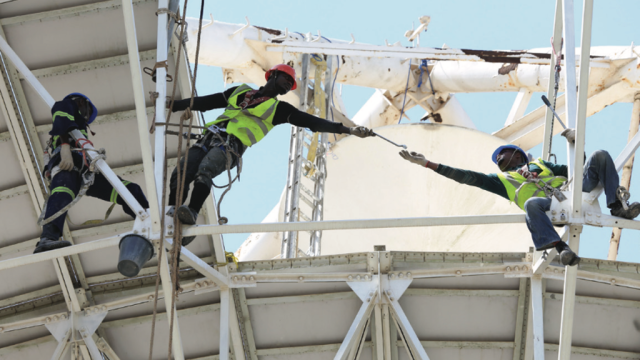Astronomy needs expensive things, and lots of them. You might remember that astronomers almost literally turned the Earth into a telescope just to see a black hole, by combining lots of existing radio telescope dishes.
Image: SKA South Africa
[referenced url=”https://gizmodo.com.au/2017/03/scientists-are-turning-earth-into-a-telescope-to-see-a-black-hole/” thumb=”https://i.kinja-img.com/gawker-media/image/upload/s–Hv6u4BCR–/c_scale,fl_progressive,q_80,w_1600/rchzhuhxwlvacqojcquh.png” title=”Scientists Are Turning Earth Into A Telescope To See A Black Hole” excerpt=”Black holes may be one of the universe’s most bizarre phenomena. They’re literally divide-by-zeros in the sky, places where the mathematics of Albert Einstein’s theory of general relativity falls apart. These dense behemoths have such strong gravitational fields that time stops, and all futures point directly at the centre, and light crossing the boundary, or event horizon, can’t escape. But no one’s ever taken a picture of a black hole, and scientists want to change that.”]
There are telescopes in all sorts of places — Hawaii, the desolate Chilean desert, heck, there’s even one at the South Pole. But Africa has plenty of old telecommunications dishes poised to serve a new purpose. And now, one of those dishes in Ghana is being turned into the first African radio telescope outside South Africa. Nature reports:
The telescope, in Kuntunse near Accra, is the first of an array of such instruments expected to be built across Africa over the next five years, and forms part of long-term plans to develop the skills of astronomers on the continent. It made its first observations this year and will be formally opened later in 2017.
The story began with a Google Maps search for scrapped telecommunications dishes a few years ago, which ultimately brought South African scientist Michael Gaylard to the Ghana dish. Gaylard has since passed away, but now scientists are retrofitting the thing, which hasn’t been easy. Telescopes are usually built to spec, but this time around engineers have needed to fit their plans around what they have. Electricity, and a reliable internet connection, have been spotty as well.
Africa offers a good location for Very Long Baseline Interferometry — combining lots of telescopic data taken at the same time — especially if scientists want to take a picture of the black hole at the centre of our Milky Way galaxy. Dan Marrone, experimental astrophysicist at the University of Arizona, previously told me that our galactic centre lies south of the celestial equator. That means radio telescope sites further north, like those in Europe, see it quite low on the horizon — places like Ghana, Zambia, Kenya and Madagascar have a much better view. Of course, scientists at these locations may want to do astronomy on their own, outside of VLBI.
Funding has come from South Africa, according to the Nature report, whose Square Kilometer Array lab hopes to benefit from more dishes on the continent. The SKA will consist of a square kilometre’s worth of dishes spread across Australia and South Africa to do high-resolution radio astronomy. The African Renaissance and International Co-Operation Fund has also given around $US9 million ($12 million) to the project so far. Ghanan astronomers will be able to use the experiment to look at any radio wave sources, like pulsars.
So, here’s to looking at space, kids.
[Nature]
